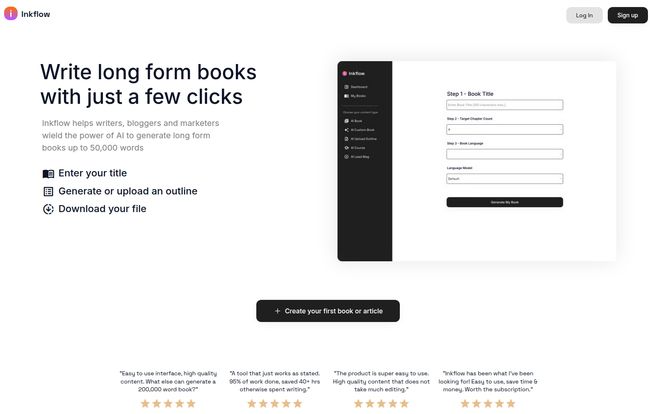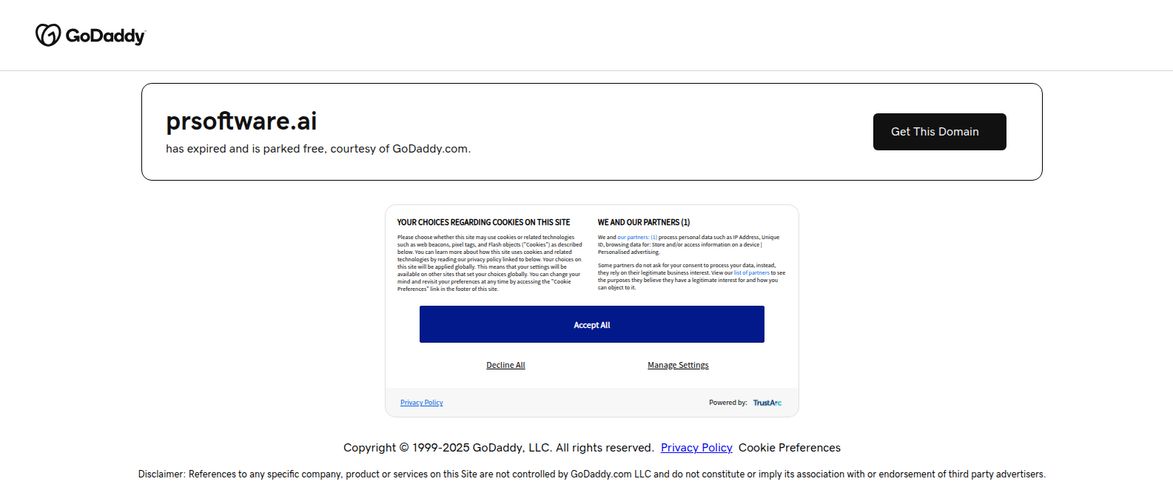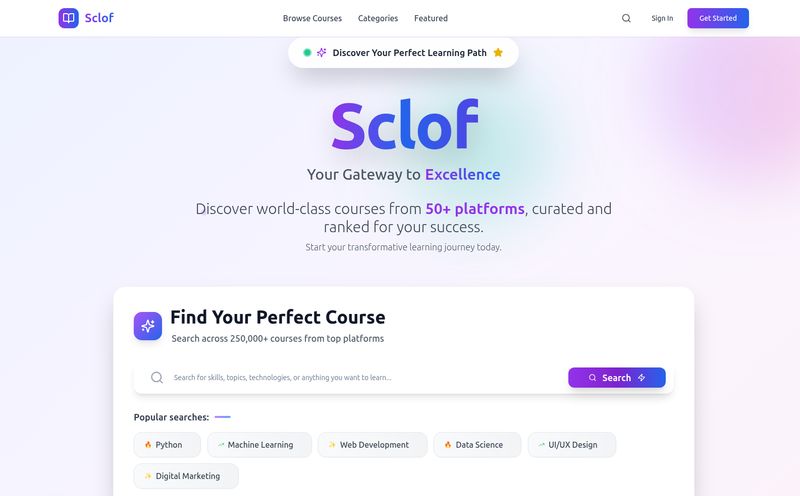The content treadmill is spinning faster than ever. Every SEO guru, marketing influencer, and their dog is telling you to create more long-form content. Pillar posts. Ebooks. Whitepapers. Entire novels for Amazon KDP, for crying out loud. And they're not wrong, but who has the time? Between client work, keyword research, and just trying to have a life, sitting down to write 10,000 words feels like planning an expedition to Mars.
I've seen a dozen AI writers pop up, all promising to be the magic bullet. Most of them are… okay. They can whip up a decent 500-word blog post or some ad copy. But a whole book? That's a different beast entirely. So when I stumbled upon Inkflow, a tool that boldly claims you can "write long form books with just a few clicks," my professional curiosity (and a healthy dose of skepticism) kicked in. Is this for real, or just another overhyped gadget? I decided to take a look.
So, What's the Big Deal with Inkflow?
At its core, Inkflow is an AI-powered book and article generator. You give it a push, and it starts running. The main promise is speed and scale. We're not talking about short blog posts here; the platform is designed to pump out massive amounts of text—the landing page throws around numbers like 50,000 or even 100,000+ words. The idea is to take the monumental task of writing a book or a massive guide and condense it from a months-long marathon into a weekend sprint.
It’s kind of like having an incredibly fast, slightly un-caffeinated ghostwriter on demand. You're still the director, the brains of the operation, but it does all the heavy lifting of putting words on the page.
How You Can Generate a Book in 3 Steps
The process itself seems almost insultingly simple, which I appreciate. I don't need another complex tool with a hundred buttons I'll never click. Here’s the breakdown:
- Just Enter the Title. This is your starting pistol. You give the AI the main topic or the working title of your book, like "The Ultimate Guide to Digital Marketing" or "My Sci-Fi Epic About Space Kittens."
- Provide Your Outline. This is the most important step, and where you, the human, really shine. You can let Inkflow generate an outline for you, which is great for brainstorming. But the real power move is to upload your own custom outline. You define the chapters, the sections, the flow of the entire book. The more detailed your outline, the better and more coherent the final product will be. This is a non-negotiable for anyone serious about quality.
- Choose a Language and Go. You pick your language (they've got English, German, Italian, and Spanish) and hit the big green button. Then you go grab a coffee while the AI does its thing.

Visit Inkflow
First Impressions and The Tech Behind It
The interface is clean. It's not trying to be everything to everyone. It's a specialized tool and it looks the part. One thing that caught my eye was the mention of being "powered by AWS for fast, secure content generation and storage." For the non-techy folks, that just means it's built on Amazon's robust cloud infrastructure. It’s a good sign; it suggests reliability and security, and your half-finished manuscript isn't just sitting on some dusty server in a garage somewhere.
They also have cloud storage integration, which should be standard but you'd be surprised how many tools don't. The thought of losing a 50,000-word draft because of a browser crash is enough to give any writer cold sweats. So, kudos for that.
But What About the Content Quality?
This is the million-dollar question, isn't it? An AI can write a billion words a second, but if it's all nonsensical garbage, what's the point? The testimonials on their site are glowing, with users claiming it produces "high-quality content that does not need much editing."
In my experience with AI, I'd take that with a grain of salt. Let's be realistic: AI is a first-draft machine. It's a phenomenal way to blast through the initial, painful phase of getting ideas down. But it's not going to write a New York Times bestseller for you while you nap. The output will always need a human touch—your voice, your stories, your unique perspective. You still need to edit, fact-check, and polish it until it shines. Think of Inkflow as the clay, not the finished sculpture.
Who Should Actually Consider Using Inkflow?
I can see a few types of people getting a ton of value from a tool like this:
- The Prolific Self-Publisher: If you're in the Amazon KDP game, you know that volume can be a huge advantage. Inkflow could help you create a series of non-fiction guides, planners, or even fiction series outlines at a speed that's humanly impossible.
- The Overwhelmed Content Marketer: Need a 15,000-word pillar post on a complex topic? Or an ebook to use as a lead magnet? This tool could slash your production time from weeks to days, freeing you up to focus on promotion and strategy.
- Anyone with Crippling Writer's Block: Staring at a blinking cursor is a special kind of hell. Using Inkflow to generate a first draft based on a rough outline can be the kickstart you need to get the creative juices flowing again. It's easier to edit something that exists than to create from nothing.
The Potential Downsides to Consider
No tool is perfect. While I'm pretty optimistic about Inkflow, there are a few things that give me pause. First, it’s a subscription. At $99 a year, it's not going to break the bank, but it's still a commitment. Some people just prefer to buy a tool once and own it.
The second is a small but odd limitation: their "AI Book Course" is currently only available in English. It's a bit strange when the tool itself is multilingual. And finally, the biggest con is one that applies to all AI writers: you still have to do teh work. You cannot escape the editing process. If you're hoping for a completely hands-off solution, this ain't it. You need to be prepared to roll up your sleeves and refine the output.
A Look at Inkflow's Pricing
The pricing structure is refreshingly simple. One plan, one price. No confusing tiers to wade through. I appreciate that.
| Plan | Price | Key Features |
|---|---|---|
| Inkflow Annual | $99 / year | Generate 20,000+ word books, auto-generated outlines, cloud storage. (They also claim 100k+ words elsewhere, so the exact generation limit per project might be worth clarifying). |
Breaking it down, $99 a year is less than what you’d pay for a couple of hours of a human freelance writer's time. If it saves you even 10-20 hours of work over a year, it has more than paid for itself. It's a value proposition based on time, and for busy professionals, time is everything.
Frequently Asked Questions about Inkflow
I dug through their FAQ section to pull out the most important bits. And yes, during my research I even found a 404 page—see, even the pros hit dead ends sometimes!
- Is there a limit on how much content you can generate?
- They say there's no limit on content, which is a huge plus for power users. The pricing mentions "20,000+ word books," which might refer to a soft cap per single generation, but overall it seems you can create as much as you need.
- Can I really use my own custom outline?
- Yes, and you absolutely should. This is the feature that separates a generic AI article from a structured, valuable piece of long-form content. Don't skip this.
- Can I use the generated content for commercial purposes?
- Yes. The FAQ confirms you can use the output for your business, self-publish it, sell it, whatever you need. This is critical.
- How do I pay and is there a refund policy?
- They accept PayPal. Their FAQ mentions a refund policy, but as with any online service, I'd recommend reading the terms and conditions yourself before you commit.
- What AI model is it using?
- They don't specify the exact model (like GPT-4, etc.), which is common. Honestly, the name of the model matters less than the quality of the results. As long as the output is coherent and useful, the label is secondary.
My Final Verdict: Is Inkflow Worth the Hype?
So, here's my final take. Inkflow isn't a magic wand that will write your novel for you. But it is a very, very powerful lever. For a writer, marketer, or entrepreneur who understands the "garbage in, garbage out" principle and is willing to provide a strong outline and perform a final edit, this tool could be a massive productivity booster.
It’s designed for a specific purpose—creating long-form content at scale—and it appears to be well-equipped for that job. The simple pricing and straightforward process are big wins in my book. If you're constantly fighting the clock to produce more content, or if you're an aspiring author who just needs help getting that first draft monster out of the way, then investing in a tool like Inkflow could be a very smart move. It's not about replacing the writer; it's about giving the writer a jetpack.
Reference and Sources
- The official website for the tool: inkflow.ai
- A helpful guide for new authors from the The Creative Penn blog.
- Amazon's official Kindle Direct Publishing portal.



